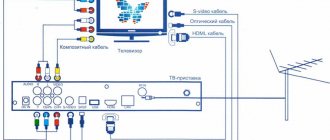Digital television in Russia will replace analog TV from January 1, 2021. The transition from analogue TV is aimed at increasing publicly available channels with high image quality for citizens of the Russian Federation. Currently, about 10% of the total population of Russia uses analogue television broadcasting.
The decision to switch off from analog signal was made more than ten years ago. At the same time, the government of the Russian Federation ordered the start of preparation of infrastructure for digital television broadcasting and began to determine the deadlines. During this time, under the control of government agencies, work was carried out to introduce digital signal transmitters.
Why is analogue terrestrial television broadcasting switched off?
In Russia, since 2009, there has been a program of transition from analogue television broadcasting to digital.
The deadline for its completion has already been postponed several times, but in 2021 the transition process will most likely end. Digital television networks have been built in Russia, so “analog” can be turned off. For 2021, funding for analogue broadcasting is not provided for in the state budget.
In municipalities with a population of less than 100 thousand inhabitants, analogue broadcasting will cease. In larger populated areas, the decision to turn off analogue is made by broadcasters (TV channels).
In the Altai Territory there are more than 100 thousand residents in only three cities - Barnaul, Biysk and Rubtsovsk.
How to set up your TV to receive a digital signal using an antenna
First, check if you are in the digital signal coverage area. This can be done on the interactive map https://map.rtrs.rf/:
- Enter your address in the search bar.
- Check the box next to “Frequency zones” in the menu on the left.
- Make sure your area is colored and has tower icons nearby.
- By clicking on the icon, you will receive information on the coverage area of this tower, as well as what packages of TV channels it broadcasts (the article describes the packages
Then make sure the antenna is pointing towards the tower. The map will also help with this - if necessary, scale it using the buttons in the lower left corner. If the antenna is indoor, install it on a windowsill to ensure the best digital signal. It should be located above the level of the window profile.
How developed is the digital TV network in the Altai Territory?
According to Altaykomsvyaz, in the Altai Territory 97.6% of the region’s residents can watch the first digital multiplex, and 52.4% of the residents can watch the second.
248 settlements are not covered by the digital television broadcasting network at all; about 53 thousand people live in them. Altaykomsvyaz promises to publish the list later.
Family in front of the TV.
CC0
Further actions depend on the TV model:
At the end of the search, a list of found channels will be displayed on the screen. If this does not happen, it means the antenna is not picking up the signal. Try changing its direction or location. In the case of a set-top box, channel switching is carried out by the remote control.
One antenna can be connected to several set-top boxes, for this they have a corresponding connector on the back.
What should residents of villages where there is no digital TV do?
Altaykomsvyaz has entered into an agreement with the digital satellite television operator NTV Plus. He is ready to provide free digital satellite television to residents of the region who do not have the opportunity to receive a digital terrestrial TV signal.
Villagers will be able to watch 20 mandatory public channels of the first and second multiplex for free. But you will have to purchase the equipment (plate) yourself, albeit at a reduced price. The department did not specify what the size of the benefit would be.
To connect, you need to call the number 8 800 555 67 89 and say the code word “Country”. Without benefits, NTV Plus satellite TV sets cost from 3.5 thousand to 8 thousand rubles.
TV. Apartment. Housing.
Open sources on the Internet
What are the benefits of switching from analogue television?
Digital TV has clearer image and sound, saves frequency resources and allows you to use modern services, such as an interactive program and subtitles for the hearing impaired. The signal arrives without interference, transmits video in Full HD and 4K formats, and content can be easily recorded and broadcast via the Internet if desired.
Another advantage is that in remote areas now not 2-3, but up to 20 channels will be available, and for free.
What will happen to local city and regional television companies?
It is possible that after switching off analogue broadcasting, local television companies that worked in this format will close. Many of them do not have the equipment to produce news and television programs in digital quality. There is also no place for them in multiplexes.
The fate of local television in the situation of transition to digital has long been discussed. So far, the state has found a place in multiplexes and a suitable work format for regional releases of State Television and Radio Broadcasting Company programs.
In addition, an auction was held for space in multiplexes for one regional channel in each subject. In the Altai Territory it was won by “Katun 24”. It will be placed on the 21st button.
Altaykomsvyaz explained that the continuation of broadcasts in the “analogue” of regional, municipal and private channels in 2021 will remain at the discretion of the broadcasters. “That is, there will be no forced shutdown of analogue. The analogue broadcast format will remain as long as there is a need for it among TV viewers and broadcasters,” the department says. What this will mean in practice is not yet clear.
An alternative option for switching to digital
Want to watch more channels? Then you need to connect digital or cable TV provided by your provider. This option will require a monthly subscription fee, but has a number of advantages:
- From 50 to 200 channels are available for viewing, including local channels using an analog signal;
- The provider is responsible for the reliability of television broadcasting;
- in dense urban areas, there is no need to look for where to install the antenna;
- In addition to television, the Internet becomes available, and therefore IPTV with additional interactive functions - pressing pause during broadcasts, watching the right programs at the right time, and an expanded list of TV channels.
To connect cable TV, use the search service for providers at your home address.
How to connect two TVs to a digital set-top box
To do this, one of the TVs must have an HDMI input. The connection is made according to the following scheme:
This method has disadvantages:
- You won’t be able to watch different channels on two TVs;
- if you watch TV in one room and the set-top box is in another, you will have to go there every time to change channels;
- RCA cables are available in lengths up to 5 meters. If the distance is greater, you will have to buy RCA plugs and cable separately, and then connect them yourself.
Available channels
The introduction of digital broadcasting is an opportunity for Russians to receive for free a whole range of TV channels that could previously be received as part of paid packages. There will be 2 multiplexes available, each of which includes 10 titles broadcast on the same frequency:
- RTRS-1 includes all-Russian national TV channels: Channel 1, Russia-24, Russia K, NTV, Russia-1, Match TV, Public Television of Russia, Karusel, Channel 5 (St. Petersburg), TV Center.
- RTRS-2 includes the winners of television broadcasting competitions (mainly entertainment topics): RenTV, MuzTV, STS, “Friday!”, “Domashny”, “Mir”, TNT, “Spas”, TV3, “Zvezda”.
Connection instructions
If you have an old TV model, then to ensure the “digital” operation you need to use a special set-top box. Modern models are equipped with T2 receivers. Therefore, you don’t need to buy anything extra for them. Make sure your device supports the MPEG-4 standard, which is valid in our country.
How to connect digital television to your TV yourself? There are two ways:
- Using a regular antenna.
- Using cable TV service.
The first option is more practical and requires less cost. If your home does not have a common antenna, then you will have to take care of choosing and purchasing this device.
For residents of Russia, two free multiplexes are currently available, allowing you to view about 20 channels. If you purchase cable television, you will have to pay monthly for this service.
Some write that a new free multiplex will soon begin broadcasting. So the number of available channels can be significantly increased. But this information is still in the air, and there is no concrete data. Therefore, for now we can classify it as a good rumor.
And now we can consider the nuances of the transition from analogue to digital TV. Let's look at five basic steps.
Step 1: purchase and installation of an antenna
If you want to set up digital TV yourself, you first need to take care of choosing an antenna. Keep in mind that there is no single universal model, so you will have to take into account the individual characteristics of housing. Also keep in mind that even in the most remote areas you can always install a device that will pick up the signal.
The most attractive option is a simple home antenna. But usually, if the tower is located far away, its power may not be enough. Interference often occurs if a truck passes near the house.
READ Match! Country: a new channel starts broadcasting!
Even good amplifiers do not always provide high-quality reception, because the waves are dampened by external obstacles.
Therefore, a home antenna is suitable only if two conditions are met:
- There is a tower next to the housing.
- The window allows you to point the antenna directly at the tower.
A more effective option would be to use an external signal receiver. After all, the waves in this case are supplied to the devices without damping through the walls of the room.
Please also note that in most cases, using an inexpensive passive antenna is sufficient to achieve acceptable quality. However, if the distance to the set-top box or TV is far, and you have to stretch a long cable, active antennas equipped with their own amplifier do a better job.
Step 2: determining the direction where the tower is located
To find out where the nearest tower is, look at the digital broadcast map. In the special menu, write the name of your locality. After this, you can estimate at what distance and in what direction the tower is located in your area.
You can check whether a settlement is in the coverage area on the website - CETV Interactive Map.
Step 3: setting up equipment to receive a high-quality signal
The quality of the received signal is constantly affected by various external factors:
- weather;
- geomagnetic storms;
- unfavorable seasons;
- air temperature;
- air humidity indicators;
- change of time of day.
All this can enhance or suppress the signal. If the tower is in direct line of sight, then problems usually do not arise. The main thing is to place the antenna in the right direction.
If the TV tower is remote, then difficulties often arise in receiving the TV signal. There is a so-called confident zone of radio waves. Outside this zone, the waves are obscured by the surface of the earth, so additional effort must be made to tune the TV broadcast.
Officially, the government is making a lot of efforts to install new towers in the right places. But this process does not proceed as quickly as we would like. If in your area the nearest tower is far away, weather conditions will have a powerful impact on the quality of the TV signal.
Try to point the antenna directly towards the transmitter and fix it securely. Find the antenna with the most suitable design by calculating its size based on its maximum gain. Please consult your retailer regarding this issue when selecting the appropriate device.
Step 4: Setting up your TV
How to connect digital TV yourself?
First you need to connect the antenna to the TV receiver using a cable. If you have a modern TV, plug the cable directly into it. If the TV is powered by a set-top box, then the antenna cable is connected to the receiver's socket.
The setup procedure in the TV menu is simple and does not cause any difficulties. But it can differ significantly for different devices. Therefore, you need to find the instruction manual for your TV and follow the steps in it.
Usually, after the first launch, you can use the auto-installation function. Most often, this is enough to establish signal reception from the antenna via cable.
Step 5: Search for channels
The easiest way to find channels is to use the automatic tuning feature. Each device enables this feature differently. Therefore, use the operating instructions for your TV model.
Until the auto search is completed, do not turn off the TV. If you can't find channels, most likely the receiver is not receiving a signal from the antenna. It may also be that the antenna is not receiving a signal. Try changing its direction, and then start the auto search again.
Sometimes users prefer to use manual search. A list appears on the TV screen into which data on the broadcast frequency is entered. Manual adjustment allows you to achieve the best picture quality in situations where auto search cannot cope with this task.









